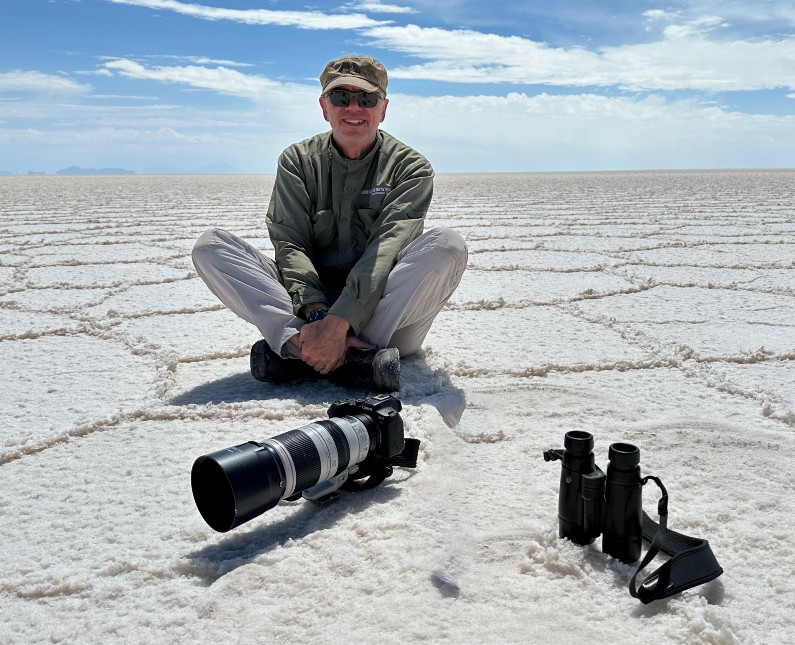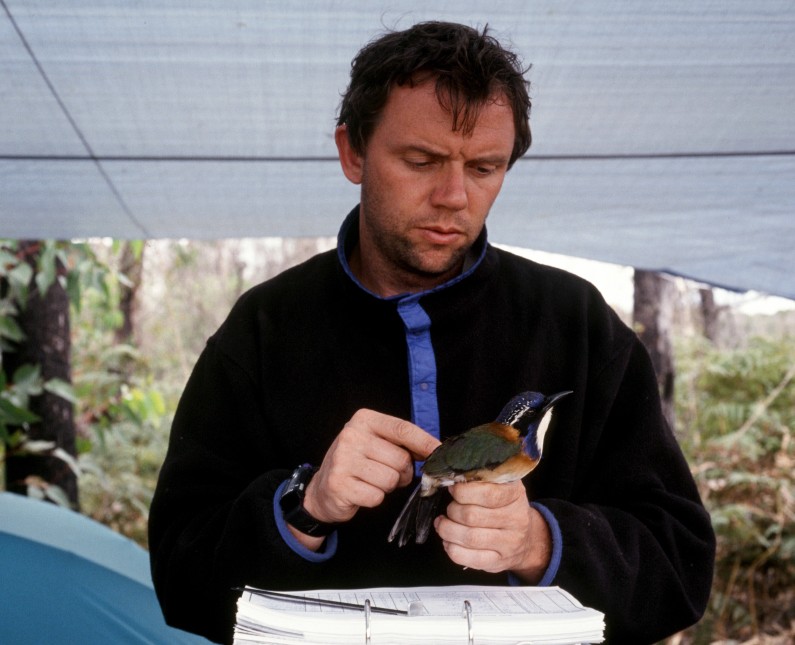Hello, my name is Olivier Langrand. As a conservationist driven by both training and passion, I have dedicated my professional life to preserving biodiversity. Currently, I serve as an Advisory Board member for the Mohamed bin Zayed Species Conservation Fund. Over the years, I have had the privilege of working with esteemed organizations such as the World Wildlife Fund (WWF), Conservation International (CI), Island Conservation (IC) and my current role at the Critical Ecosystem Partnership Fund (CEPF), all in pursuit of making a positive impact on our planet’s natural heritage.
EDITOR Hello Olivier, thanks for your time, we’re looking forward to getting to
know you.
OLIVIER LANGRAND Likewise, I’m excited to share my experiences.
ED I can’t quite place your accent, can you help me?
OL I am a French national, but lived all over the world including Madagascar, Gabon,
South Africa, and the United States of America.
ED How long have you been part of the Fund, and what drew you to this position?
OL I joined MBZ Species Conservation Fund as a member of the Advisory Board in 2019. I am recommending for funding projects related to bird conservation.
ED How did your conservation journey begin?
OL My academic background is in zoology, and I am a passionate birdwatcher which is the reason why I was approached to fulfil this function in the context of the Advisory Board of MBZ Species Conservation Fund.
ED When did your love for conservation begin?
OL Since I was a child, I was interested in nature with a strong bias for birds. I traveled at a young age to observe birds first domestically in France and rapidly internationally. The situation faced by many bird species triggered my interest in nature conservation in general and species conservation in particular.
ED Why birds?
OL I studied the effects of forest fragmentation on the endemic birds of Madagascar for my MSc dissertation (University of Natal Pietermaritzburg). Birdwatching is my only serious hobby. As of today, I have seen 5,494 bird species which represent 50.75% of all the bird species of the world and I have visited 181 countries and territories in search of birds.
ED That’s insane, what is your favourite bird species and why?
OL I would say that it is the Peregrine Falcon. It is obviously a beautiful bird of prey, present on six continents, with extraordinary performance as far as the speed reached to catch a prey in flight, but it is also because of its resilience. The Peregrine Falcon was under major threats in the 70s and 80s because of poaching by falconers but mostly by the use of DDT by the agriculture sector that lowered the Peregrine Falcon’s reproduction success and survival rate. As a teenager in France, I was a part of group who camped by an occupied nest of Peregrine Falcon during the entire time of the nesting period to prevent that no birds would be poached. With the ban of DDT in 70s in the US and in the 70s and 80s in Europe the population of Peregrine Falcon recovered rapidly, and it is now considered as a relatively common species, nesting in various natural ecosystems but also on buildings in urban areas.
ED What makes the MBZF such an amazing Fund?
OL MBZ Species Conservation Fund is an efficient funding stream to support species conservation undertaken by conservationists, academics, individuals, and even private entities. The proposal selection is made rapidly by experts of the different taxonomic groups and the funding reach the grantees swiftly. The money is put in the hand of people best equipped to deliver species conservation on the ground without restriction of countries.
ED What is the most inspiring Fund project you’ve come across?
OL It is difficult to choose among all the projects funded to find the most inspiring one. However, Manu SOP (www.manu.pf ), an organization involved in bird conservation in French Polynesia, has worked tirelessly to conserve the Tahiti Monarch a bird species listed as Critically Endangered on the IUCN RedList. The global population numbered 21 individuals in 1997 and 44 in 2012 and the population of this threatened species keeps growing. This is the result of the commitment of dedicated staff of Manu SOP who have delt with threats affecting this species. They got involved in the control of invasive alien species of mammals and bird such as House Rat, Common Myna, Red-vented Bulbul but also invertebrate species such as fire-ant and plant species such as the African Tulip-tree. Without Manu SOP, the Tahiti Monarch and probably some other bird species of French Polynesia would be extinct today.
ED Oh wow, that’s amazing and incredible to see how species depend on each other. Apart from species, have you assisted any inspiring grant recipients?
OL The most extraordinary grantee that I had the chance to meet is Jean-Pierre Rouja, a native from Bermuda who has immensely contributed to the conservation of the Bermuda Petrel, also known as Cahow for the past 20+ years. The story of the Bermuda Petrel is remarkable, sad, and hopeful at the same time. When Spanish sailors passed by Bermuda in the early 1500s as part of their exploration to the New World, as they approached the coast at night, they got scared by the frightening calls of tens of thousands of Cahows that filled the sky above them. The Spaniards did not disembark in Bermuda that they named the Isle of Devils. It is estimated that a million Bermuda Petrels lived on the island before Europeans set foot on the archipelago. A few decades later, direct predation of the birds (ship logs report collecting 4,000 birds per night to feed the sailors), voluntary introduction of pigs and unvoluntary introduction of rats resulted in a rapid decrease of the population of the Bermuda Petrel and by 1620 the Bermuda Petrel was considered extinct. For 300 years the Bermuda Petrel has been a ghost species. No one had seen this species until 1951 when an expedition led by Louis L. Mombray discovered seven nesting pairs on an islet of the archipelago. Then started a conservation program of the Bermuda Petrel that included the removal of rodents from islets where the petrel was nesting, and the ecological restoration of the islets. This process started in the mid-1960s with a conservation champion called David Wingate who passed on the baton to Jeremy Madeiros in the early 2000s. Today, the Bermuda Petrel nests on six islets of the archipelago. On the largest one called Nonsuch Island, a colony has been established through the translocation of birds from other islets. The rewilding of Nonsuch Island took 60 years but has been a real success, not only for the endemic petrel, but also for one endemic lizard, two endemic snails and several endemic tree species, all listed as Critically Endangered on the IUCN Red List of Threatened Species. Jean-Pierre Rouja, a private entrepreneur, created a conservation NGO called the Nonsuch Expeditions that supports and collaborates in the ongoing conservation work on Nonsuch Island, assisting the warden Jeremy Madeiros and the Department of the Environment and Natural Resources of the Government of Bermuda, in a large conservation operation that involved conservation on the ground and public awareness through the establishment of a large social science program. Jean-Pierre Rouja put his soul, strength, time and money in the conservation of the national bird of Bermuda and continues to support financially and technically this iconic conservation project.
ED That’s a wonderful story and a perfect example of how individuals have the power to create positive change.
ED What is your most memorable Fund experience?
OL Memorable story related to the MBZ Advisory Board is when we went to the Pantanal, Brazil and when we saw 12 different jaguars, an estimated 10 to 20% of the regional population, over three days.
ED Do you have any parting words of wisdom for our readers?
OL My motto is “species extinction is not a fatality – We must do whatever is possible to prevent a species from going extinct”.
ED Well said and a nice way to end our time together. Thank you for your time and we’ll keep an eye for the cool Bird related projects supported by the Fund in years to come.
OL Thank you very much for the opportunity.



